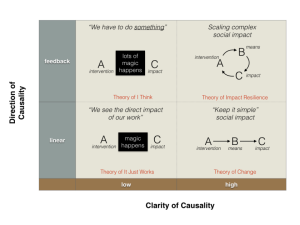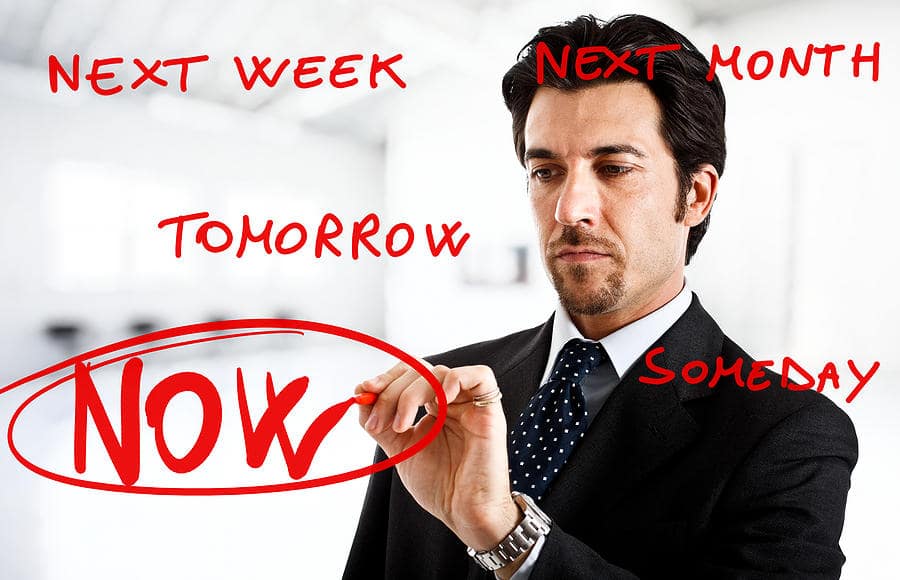This post is provided by Metcalf & Associates and collaborator Jim Ritchie-Dunham  as a companion for the March 22 Voice America interview with Christoph Hinske focusing on How Big Change Happens in his keynote presentation to the World Green Building Council. Jim is president of the Institute for Strategic Clarity, a trustee of THORLO, and an adjunct faculty member at the EGADE Business School and at Harvard. In this post Jim talks about his  âtheory of impact resilience.â While a theory of change focuses on how a change in an intervention will lead to a change in specific means, which will drive change in a specific social impactâin a linear modelâa theory of impact resilience looks at the system of causes, effects, feedback, and stakeholders that lead some interventions to generate a much more resilient system that delivers much greater, sustained impact. This information is for leaders who have struggled to successfully implement complex change using linear models and want to better understand alternative approaches that will increase the probability to success for much needed and highly visible change projects.
More and more people are looking to large-scale social change processes to leverage their impact around very complex issues. From poverty, health, education, epidemics, and inequity to water, air, green building, and renewable energy. Scaling collective impact is everywhere. I have been looking at, and engaging with many of these efforts, for two decades now. In trying to figure out how to support large-scale change, many groups are trying to become evermore strategic. As a big proponent of strategic clarity, I encourage the strategic dialog, and I encourage pathways that will support a group in getting to greater clarity about what they can do together and what will work.
In their strategic development processes, many groups now focus on developing a âtheory of change.â I agree that it is far easier to learn and refine a strategy when you have a theory of what you are going to do. And, I see some inherent difficulties in the way many groups currently frame their theory of change. Hopefully a brief picture will clarify what I see as the intention and a better answer.
To start with, I see that most social-change efforts grow up around an effort that initially worked. There was an intervention and there was an impact. While not quite sure how it worked, the impact is there. We created a kitchen, and more people were fed tonight. In this experience, there is typically an implicit theory of âit just works.â We do this, and we see the impact. Usually the distance in time and space between the intervention and the impact is very low or immediate. We can see it directly. I see this as the lower-left quadrant in the 2Ã2 matrix below, low clarity of causality with a linear direction of causality.
This success often leads to the desire to scale the work, to get much greater impact. Â To scale up the intervention often requires investment of greater capital. Â Investors of this greater capital usually want to see a greater understanding of how the intervention will lead to the means that will drive the impact. Â Greater investment wants to lower the risk of not understanding. Â They want to see a theory of âchange,â a âcomprehensive description and illustration of how and why a desired change is expected to happen in a particular context.â Â As far as I can tell, from what I see in foundation, nonprofit, and network reports and in my own conversations, most of these theories of change provide linear descriptions of how an intervention will lead to some specific means of change in a specific context that will lead to the desired social impact. Â A to B to C. Â I see this as the lower-right quadrant in the 2Ã2 matrix above, high clarity of causality with a linear direction of causality. Â While this greater clarity of causality makes it much easier for the intervention leaders and the funders to test whether the intervention leads to the expected means and impacts, this linear approach to complex social issues leaves out a critical realityâfeedback.
If the decisions you make today affect the decisions you can make tomorrow, then there is feedback. Â A to C to A. Â If the decisions you make influence others who then influence you, there is feedback. Â All complex social issues contain impacts of any intervention on other stakeholders and on resources that influence the ability to continue to intervene in the future. Â They all have feedback.
As the complexity of an intervention increases, like trying to feed a whole city through a large network of kitchens, most efforts seem to try to continue what they were doing before with just a lot more resources.  They use the same logic, on a bigger scale.  Lots of intervention, mixed with lots of magic, leads to lots of impact; so goes the âtheory of I think.â  I think that if we just ⦠ I see this as the upper-left quadrant in the 2Ã2 matrix above, low clarity of causality with a feedback direction of causality.  While the situation might be much more complex, with many more stakeholders and resources involved, I think if we just do a lot more, we will get much more impact.  It rarely works, often because of the unseen feedback effects, which is why social impact investors have moved more and more towards wanting to see something that demonstrates a greater clarity of causality.  Right now the best-in-class practice seems to be the âtheory of changeâ I mentioned earlier.
To complete the high-level overview a theory of change provides of preconditions, pathways, and interventions to achieve the desired impact, many groups develop a complementary logic model and evaluation plan. The logic model lays out a linear model of how the planned work with resource inputs and activities leads to the suggested outputs, outcomes, and eventual impact. A very clean and relatively simple way to explain how to implement the theory of change.The evaluation plan then provides measures to test the hypotheses for the different elements: the resource inputs; the activities; the outputs; the outcomes; and the impacts. The strategy process then pulls together the theory of change, the logic model, and the evaluation plan, in a crisp, linear mapping.
Now, if (1) the social issues we face require much greater investment, influencing a greater number of stakeholders, in contexts of much greater feedback, and (2) a linear strategy based on a theory of change, logic model, and evaluation plan falls short of dealing with the feedback complexity, what do I suggest? Â A âtheory of impact resilience.â While a theory of change focuses on how a change in an intervention will lead to a change in specific means, which will drive change in a specific social impactâin a linear modelâa theory of impact resilience looks at the system of causes, effects, feedback, and stakeholders that lead some interventions to generate a much more resilient system that delivers much greater, sustained impact. Â I see this as the upper-right quadrant in the 2Ã2 matrix above, high clarity of causality with a feedback direction of causality.
Over the past twenty years, with many colleagues around the globe, we have developed systems-based strategic approaches to engaging multiple stakeholders around complex social issues. Â There is now a whole industry of such approaches. Â It turns out that it is not hard to bring together many people who are passionate about any specific social issue, find out how they each contribute different elements of the solution, and how they can work together to change the behavior of the whole system. Â In the past decade alone, people have applied this kind of approach successfully on six continents to hundreds of important, complex social issues. It only takes the will to do it, a little know-how and a few elapsed months of work. Not decades.
So, while I applaud the desire of social impact investors to dramatically increase the clarity of causality between an intervention and a social impact, it is time that we move beyond âkeep it simple,â linear models of causality to incorporate multi-stakeholder, feedback models of causality. A theory of impact resilience, based on systems-based strategic approaches suggests how. It provides a systemic theory, it lays out the systemic logic of how the interventions lead to shifts in the system of stakeholder responses and subsequent systemic impacts, and it provides an impact resilience scorecard of the systemic measures that indicate how the interventions are leading to systemic shifts, to greater resilience, and to scaling of the impacts.
To become a more innovative leader, please consider our online leader development program. For additional tools, we recommend taking leadership assessments, using the Innovative Leadership Fieldbook and Innovative Leaders Guide to Transforming Organizations, and adding coaching to our online innovative leadership program. We also offer several workshops to help you build these skills.
You can tune in live every Tuesday at 11am PST to Innovative Leaders Driving Thriving Organizations






